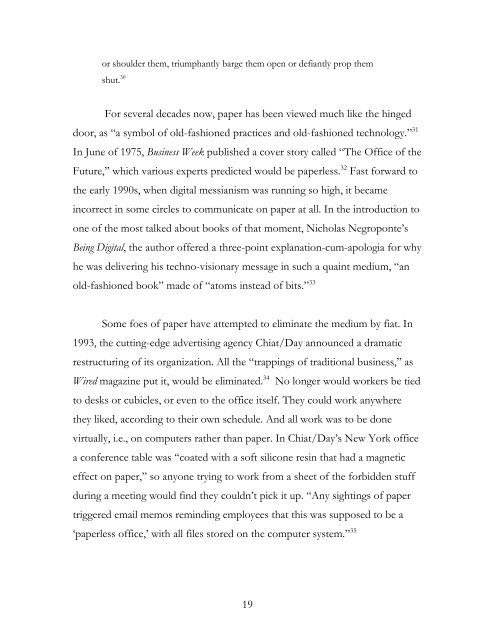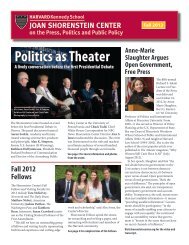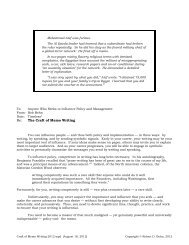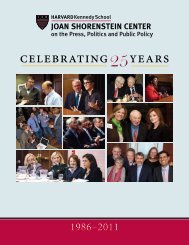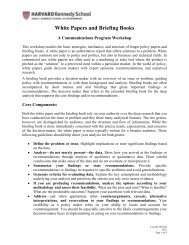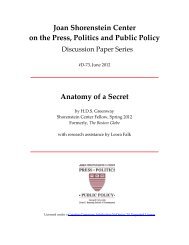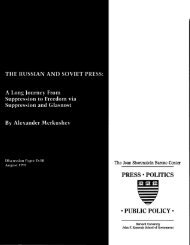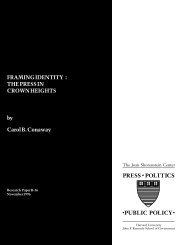Why Paper Is Eternal - Joan Shorenstein Center on the Press ...
Why Paper Is Eternal - Joan Shorenstein Center on the Press ...
Why Paper Is Eternal - Joan Shorenstein Center on the Press ...
You also want an ePaper? Increase the reach of your titles
YUMPU automatically turns print PDFs into web optimized ePapers that Google loves.
or shoulder <strong>the</strong>m, triumphantly barge <strong>the</strong>m open or defiantly prop <strong>the</strong>m<br />
shut. 30<br />
For several decades now, paper has been viewed much like <strong>the</strong> hinged<br />
door, as “a symbol of old-fashi<strong>on</strong>ed practices and old-fashi<strong>on</strong>ed technology.” 31<br />
In June of 1975, Business Week published a cover story called “The Office of <strong>the</strong><br />
Future,” which various experts predicted would be paperless. 32 Fast forward to<br />
<strong>the</strong> early 1990s, when digital messianism was running so high, it became<br />
incorrect in some circles to communicate <strong>on</strong> paper at all. In <strong>the</strong> introducti<strong>on</strong> to<br />
<strong>on</strong>e of <strong>the</strong> most talked about books of that moment, Nicholas Negrop<strong>on</strong>te’s<br />
Being Digital, <strong>the</strong> author offered a three-point explanati<strong>on</strong>-cum-apologia for why<br />
he was delivering his techno-visi<strong>on</strong>ary message in such a quaint medium, “an<br />
old-fashi<strong>on</strong>ed book” made of “atoms instead of bits.” 33<br />
Some foes of paper have attempted to eliminate <strong>the</strong> medium by fiat. In<br />
1993, <strong>the</strong> cutting-edge advertising agency Chiat/Day announced a dramatic<br />
restructuring of its organizati<strong>on</strong>. All <strong>the</strong> “trappings of traditi<strong>on</strong>al business,” as<br />
Wired magazine put it, would be eliminated. 34 No l<strong>on</strong>ger would workers be tied<br />
to desks or cubicles, or even to <strong>the</strong> office itself. They could work anywhere<br />
<strong>the</strong>y liked, according to <strong>the</strong>ir own schedule. And all work was to be d<strong>on</strong>e<br />
virtually, i.e., <strong>on</strong> computers ra<strong>the</strong>r than paper. In Chiat/Day’s New York office<br />
a c<strong>on</strong>ference table was “coated with a soft silic<strong>on</strong>e resin that had a magnetic<br />
effect <strong>on</strong> paper,” so any<strong>on</strong>e trying to work from a sheet of <strong>the</strong> forbidden stuff<br />
during a meeting would find <strong>the</strong>y couldn’t pick it up. “Any sightings of paper<br />
triggered email memos reminding employees that this was supposed to be a<br />
‘paperless office,’ with all files stored <strong>on</strong> <strong>the</strong> computer system.” 35<br />
19


